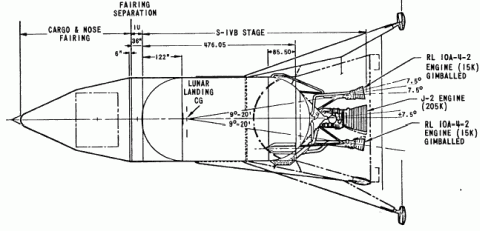
Home - Search - Browse - Alphabetic Index: 0- 1- 2- 3- 4- 5- 6- 7- 8- 9
A- B- C- D- E- F- G- H- I- J- K- L- M- N- O- P- Q- R- S- T- U- V- W- X- Y- Z
Apollo LASS S-IVB

LASS
AKA: Lunar Application of a Spent S-IVB Stage. Status: Study 1966.
The mission was an unmanned, direct-flight, using an existing lunar beacon to obtain a precise landing location. The LASS required either a highly throttleable J-2 type engine (J-2X) or a moderately throttleable J-2S with RL-10 engines added to provide proper landing control.
DAC studied several configurations and recommended a vertical lander with a payload package on top. Landed payloads in the order of 11,000 kg were claimed by DAC with the 1965 Saturn V capability. This payload was based on a more optimistic delta-V budget than used in other studies. However, the landed payload would still be substantial (7200 - 8600 kg) using the more conservative values. The LASS was related to contemporary Douglas SASSTO studies on use of a modified S-IVB as a reusable, recoverable upper stage or as a single-stage-to-orbit launch vehicle.
Family: Lunar Landers, Lunar logistics spacecraft, Moon. Country: USA. Agency: NASA, Douglas. Bibliography: 1993.
Back to top of page
Home - Search - Browse - Alphabetic Index: 0- 1- 2- 3- 4- 5- 6- 7- 8- 9
A- B- C- D- E- F- G- H- I- J- K- L- M- N- O- P- Q- R- S- T- U- V- W- X- Y- Z
© 1997-2019 Mark Wade - Contact
© / Conditions for Use